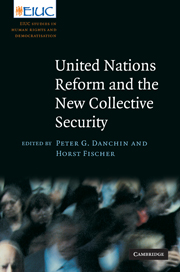Book contents
- Frontmatter
- Contents
- List of contributors
- Series editors' preface
- Preface
- List of abbreviations
- Introduction: the new collective security
- PART I Law and politics in United Nations reform
- 1 Things fall apart: the concept of collective security in international law
- 2 Reflections on the politics of institutional reform
- 3 Great Powers then and now: Security Council reform and responses to threats to peace and security
- PART II Defining “threats” to collective security
- PART III Prevention and responses
- PART IV Perspectives on the ground
- Bibliography
- Index
3 - Great Powers then and now: Security Council reform and responses to threats to peace and security
from PART I - Law and politics in United Nations reform
Published online by Cambridge University Press: 05 May 2010
- Frontmatter
- Contents
- List of contributors
- Series editors' preface
- Preface
- List of abbreviations
- Introduction: the new collective security
- PART I Law and politics in United Nations reform
- 1 Things fall apart: the concept of collective security in international law
- 2 Reflections on the politics of institutional reform
- 3 Great Powers then and now: Security Council reform and responses to threats to peace and security
- PART II Defining “threats” to collective security
- PART III Prevention and responses
- PART IV Perspectives on the ground
- Bibliography
- Index
Summary
The United Nations Security Council is widely regarded as having legitimacy problems but there are serious disagreements about what exactly is at the root of these problems. In 1950, Hans Kelsen identified the veto power of the five permanent members (“the P5”) as the greatest likely source of future challenges to the legitimacy of the newly created UN Security Council. His quite prophetic thoughts are worth quoting here at a greater length:
The Security Council has almost the character of a governmental body. Hence the political measurements used for forms of government are applicable to it. The question of democracy and of autocracy becomes unavoidable. The veto right of the five permanent members of the Security Council, which places the privileged powers above the law of the United Nations, establishes their legal hegemony over all the other members of the Organization and thus stamps on it the mark of an autocratic or aristocratic regime. This is all the more critical as the United Nations presents itself ideologically as the crowning of a war waged for a victory not only of arms but of ideals, especially of the ideal of democracy. If the Security Council by its voting procedure was to be elevated by the rank of a government at all, only a democratic form of government, that is to say, the majority vote principle without veto rights of privileged members, was adequate … There is an open contradiction between the political ideology of the United Nations and its legal constitution. […]
- Type
- Chapter
- Information
- United Nations Reform and the New Collective Security , pp. 94 - 114Publisher: Cambridge University PressPrint publication year: 2010
- 1
- Cited by



